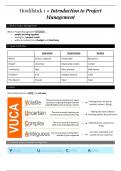Summary
Introduction to Project Management - Samenvatting
- Course
- Institution
Summary of the first-year course Introduction to Project Management from the Event and Project Management course at Artevelde University. Supplemented with personal notes from lecturer D. De Bruyne's lessons. Successful in the first session with 16/20! Summary in English as the course is also...
[Show more]



